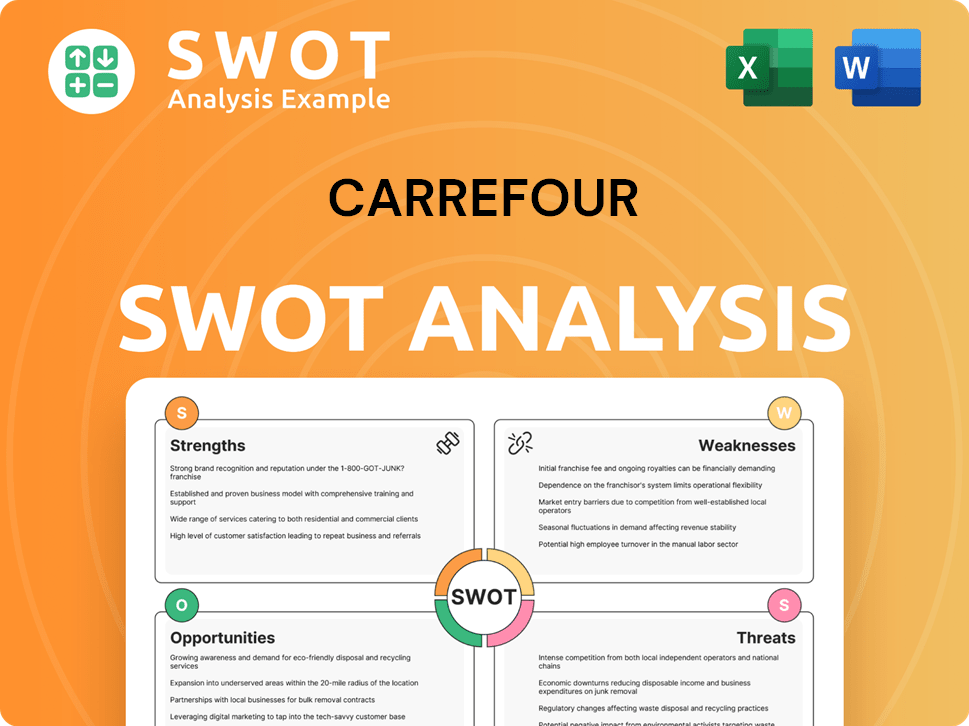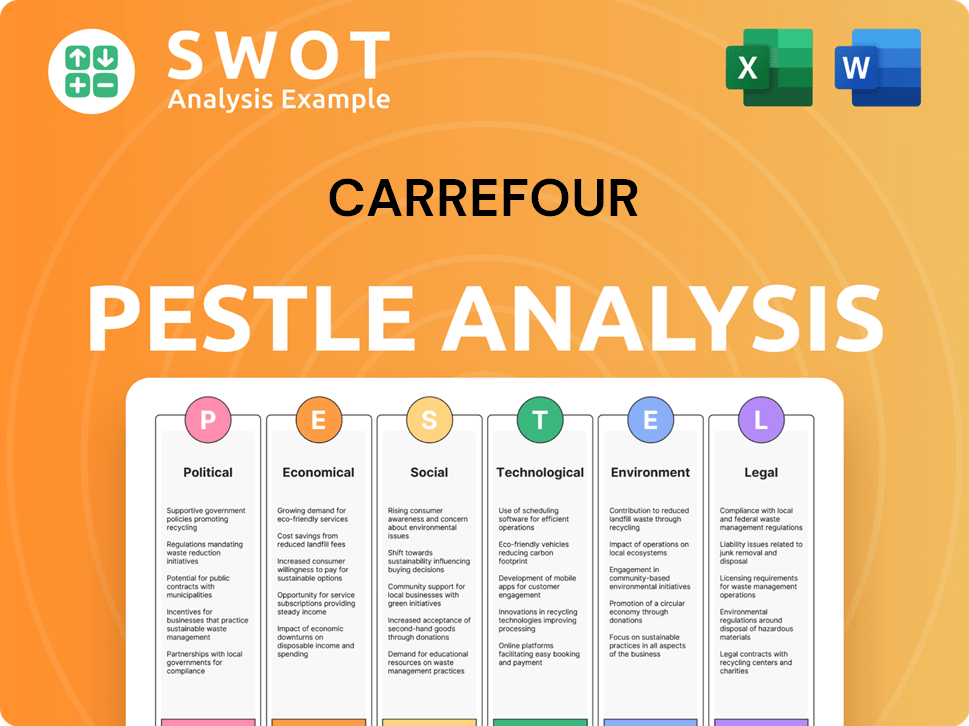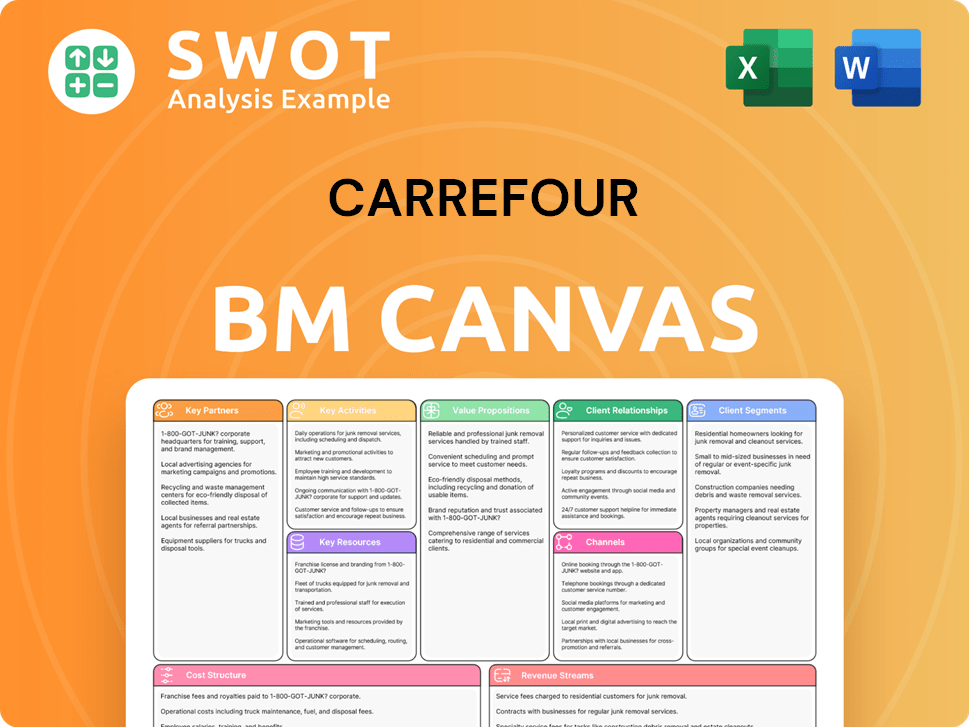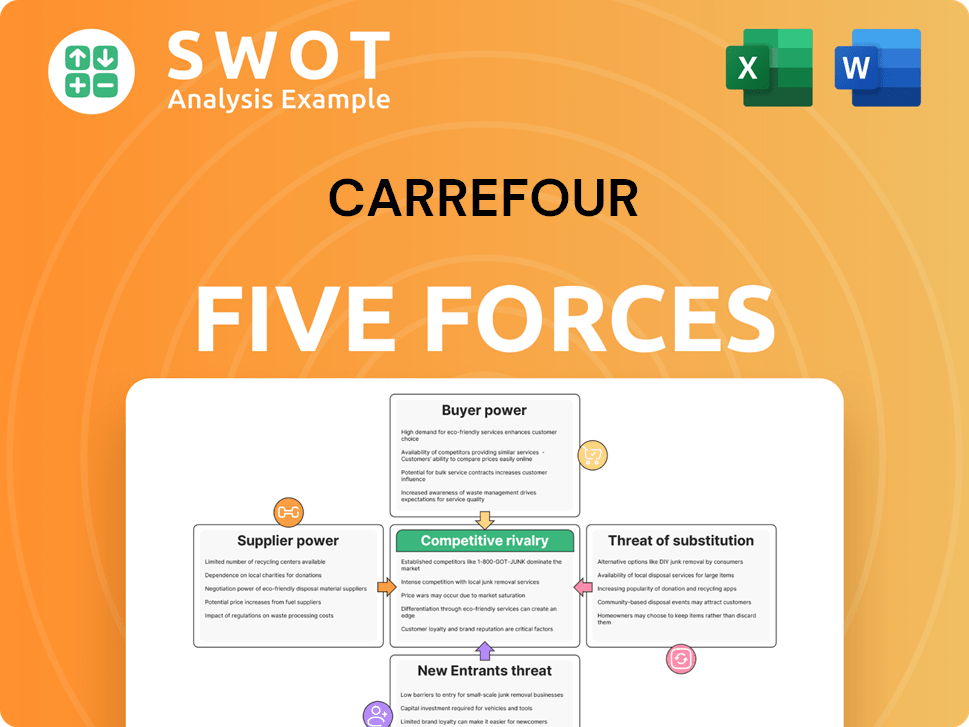Carrefour Bundle
Can Carrefour Conquer the Future of Retail?
Founded in 1959, Carrefour has evolved from a French pioneer to a global retail giant, boasting €94.6 billion in sales as of 2024. This multinational retailer, known for its hypermarket innovation, now navigates a dynamic landscape, adapting to shifting consumer demands and economic pressures. Carrefour's enduring success hinges on its ability to execute a robust Carrefour SWOT Analysis and strategic vision.

Understanding Carrefour's Carrefour growth strategy is crucial, especially considering its recent acquisitions and ambitious Carrefour strategic initiatives 2024. This article delves into Carrefour's future prospects, examining how the company plans to leverage Carrefour expansion, embrace Carrefour e-commerce strategy, and navigate the Carrefour competitive landscape to maintain and potentially increase its Carrefour market share within the Carrefour retail industry. We will also explore Carrefour business model analysis and Carrefour financial performance review to provide a comprehensive Carrefour company analysis.
How Is Carrefour Expanding Its Reach?
The Revenue Streams & Business Model of Carrefour is undergoing significant transformation, with a primary focus on strategic expansion and diversification. The company's growth strategy is centered around reinforcing its market position through various initiatives, including franchising, geographical expansion, and strategic acquisitions.
Carrefour's future prospects are closely tied to its ability to execute these expansion plans effectively. The retail industry is dynamic, and Carrefour's ability to adapt to changing consumer preferences and market trends will be crucial for its long-term success. The company's focus on both physical and digital channels reflects its commitment to meeting evolving customer demands.
Carrefour's expansion initiatives are designed to drive growth and increase its market share. These initiatives are supported by a strong financial foundation and a clear vision for the future. The company's strategic moves are aimed at creating long-term value for shareholders and stakeholders.
Carrefour is heavily investing in franchising to extend its reach and reduce capital exposure. In France, a significant portion of its stores are franchised, with 5,870 out of 6,468 stores operating under this model. This includes the entire proximity network.
In 2024, Carrefour France set a record with 454 new convenience store openings within the franchise segment. Carrefour Romania plans to accelerate the development of its Express format, targeting over 40 new integrated and franchise stores in 2025, primarily focusing on smaller locations.
Carrefour is set to re-enter the Indian market in 2025 through a franchise partnership with Apparel Group. The first stores are expected to open in the National Capital Region (NCR) by mid-2025, offering a wide range of products. Carrefour aims to expand into over ten new countries by 2026.
In February 2025, Carrefour announced its decision to acquire the outstanding shares held by minority shareholders in Carrefour Brazil, aiming for full ownership. This move, approved in April 2025, is expected to streamline operations. The integration of Cora and Match banners in France was completed on July 1, 2024, with the conversion of Cora stores to Carrefour banners completed in November 2024.
These strategic initiatives demonstrate Carrefour's commitment to growth and its ability to adapt to the dynamic retail industry. The company's focus on franchising, geographical expansion, and strategic acquisitions positions it for continued success. The synergy target of €130 million by 2027 from the Cora and Match acquisition highlights the financial benefits of these strategic moves.
Carrefour's expansion strategy involves a multi-faceted approach to bolster its market presence and diversify revenue streams. The company is focusing on franchising, geographical expansion, and strategic acquisitions to achieve its growth objectives.
- Franchising: Significant expansion of franchise models, especially in France.
- Geographical Expansion: Re-entry into the Indian market and expansion into new countries.
- Strategic Acquisitions: Full ownership of Carrefour Brazil to streamline operations.
- Synergy Targets: €130 million in synergies expected by 2027 from acquisitions.
Carrefour SWOT Analysis
- Complete SWOT Breakdown
- Fully Customizable
- Editable in Excel & Word
- Professional Formatting
- Investor-Ready Format

How Does Carrefour Invest in Innovation?
Understanding customer needs and preferences is crucial for a successful retail strategy. The company focuses on enhancing customer satisfaction through digital tools and private-label growth. This approach has led to measurable improvements, as seen in the increase in its Net Promoter Score (NPS) in 2024.
The company's focus on customer satisfaction is evident in its digital initiatives and the expansion of its private-label products. These efforts are designed to meet evolving consumer demands for quality, value, and convenience. By prioritizing customer needs, the company aims to strengthen its market position and drive sustainable growth in the competitive retail industry.
The company is actively leveraging technology and innovation to drive sustained growth and enhance its competitive edge. A significant aspect of this strategy is the acceleration of its digital transformation, which includes expanding e-commerce activities. This focus on innovation is critical for the company's future prospects.
The company's e-commerce Gross Merchandise Volume (GMV) increased by 18% to €5.9 billion in 2024. This strong growth continued into Q1 2025, with e-commerce GMV up sharply by 19%, significantly driven by Brazil. This demonstrates the success of the company's e-commerce strategy.
The company is investing in loyalty programs like 'Le Club Carrefour,' which was successfully rolled out in France in January 2025. This program offers enhanced benefits and competitive pricing on key products. These initiatives contribute to customer retention and increased sales.
The share of company-branded products continued to grow, reaching 38% of food sales in Q1 2025, up from 37% in Q1 2024. This growth in private-label products reflects the company's focus on providing value to customers. This is a key component of its Carrefour brief history.
The company is committed to sustainability initiatives, with a 111% achievement rate for its CSR and Food Transition Index in 2024. This includes a commitment to achieving zero-deforestation soy for its own-brand products by 2025. This commitment demonstrates the company's dedication to environmental responsibility.
Carrefour Fontvieille expanded its reusable packaging initiative in May 2025, in collaboration with the Prince Albert II of Monaco Foundation. This initiative aims to reduce single-use plastics. This is a practical example of the company's sustainability efforts.
The company continues to equip stores with electronic labels and install self-checkout kiosks. These technologies support store productivity and meet customer requirements. This enhances the overall shopping experience.
The company's innovation and technology strategy focuses on several key areas to drive growth and improve customer experience. These initiatives are crucial for the company's competitive landscape and future revenue projections.
- Digital Transformation: Expanding e-commerce and investing in digital infrastructure.
- Customer Loyalty: Implementing and enhancing loyalty programs.
- Private-Label Development: Increasing the share of company-branded products.
- Sustainability: Promoting zero-deforestation soy and reusable packaging.
- Store Technology: Utilizing electronic labels and self-checkout kiosks.
Carrefour PESTLE Analysis
- Covers All 6 PESTLE Categories
- No Research Needed – Save Hours of Work
- Built by Experts, Trusted by Consultants
- Instant Download, Ready to Use
- 100% Editable, Fully Customizable

What Is Carrefour’s Growth Forecast?
The financial outlook for Carrefour in 2025 reflects a strategic focus on maintaining and expanding its market position. The company's Carrefour growth strategy involves significant investments in pricing to attract and retain customers. This is supported by strategic initiatives and a new cost-saving plan, designed to fuel further expansion.
In 2024, Carrefour demonstrated strong performance, achieving a 9.9% like-for-like sales growth, reaching €94.6 billion. Adjusted EBITDA increased by 1.7% to €4.6 billion. The company's performance in key markets, such as Brazil, highlights its ability to capitalize on growth opportunities. Carrefour's focus on strategic initiatives and cost management is designed to drive future financial performance.
Carrefour's financial strategy includes a commitment to returning value to shareholders. The company increased its ordinary dividend by 6% to €0.92 per share for the 2024 fiscal year, alongside a special dividend of €150 million (€0.23 per share). This demonstrates the company's confidence in its financial stability and future prospects, reinforcing its position in the retail industry.
Carrefour's 2024 performance included a 9.9% like-for-like sales growth, reaching €94.6 billion. Adjusted EBITDA increased by 1.7% to €4.6 billion. Recurring Operating Income (ROI) reached €2.213 billion, up 1.4% excluding currency effects.
The company plans to continue investing in prices to maintain and accelerate market share gains. This strategy is supported by scaling up strategic initiatives and a new €1.2 billion cost savings plan. The company anticipates slight growth in EBITDA, ROI, and Net Free Cash Flow.
In Q1 2025, Carrefour reported a 2.9% like-for-like sales growth, reaching €22.674 billion. Brazil showed strong performance with a 5.4% like-for-like sales increase. E-commerce GMV in Brazil surged by 29%.
The company increased its ordinary dividend by 6% to €0.92 per share for the 2024 fiscal year. A special dividend of €150 million (€0.23 per share) was also announced, demonstrating confidence in Carrefour future prospects.
Carrefour's financial performance is driven by several key indicators. The company's ability to maintain Carrefour market share and expand its operations is critical. A comprehensive Competitors Landscape of Carrefour analysis can provide further insights into the company's position within the retail sector.
- Like-for-like sales growth
- Adjusted EBITDA
- Recurring Operating Income (ROI)
- Net Free Cash Flow
Carrefour Business Model Canvas
- Complete 9-Block Business Model Canvas
- Effortlessly Communicate Your Business Strategy
- Investor-Ready BMC Format
- 100% Editable and Customizable
- Clear and Structured Layout

What Risks Could Slow Carrefour’s Growth?
The growth strategy of Carrefour faces several potential risks and obstacles that could impact its future prospects. The retail industry is highly competitive, leading to price investments that affect profitability. Furthermore, regulatory changes and supply chain vulnerabilities add complexity to the company's operations.
Technological disruption and changing consumer preferences also pose challenges, particularly from e-commerce giants. Internal resource constraints and the integration of acquired businesses further complicate matters. Finally, the uncertain geopolitical environment introduces additional risks to retail operations.
Despite these challenges, Carrefour is actively addressing these risks through strategic initiatives, such as cost savings plans and diversification efforts. The company's ability to navigate these obstacles will be crucial for its long-term success and its ability to maintain or grow its market share.
Intense competition within the retail industry continues to be a major hurdle for Carrefour. This competitive landscape necessitates significant price investments, impacting profitability, especially in Europe. The sluggish market environment, marked by the end of inflation and negative volume trends, further intensifies these pressures, requiring strategic adaptation.
Regulatory changes present another layer of risk for Carrefour, especially concerning acquisitions. The Autorité de la concurrence's clearance of Carrefour's acquisitions in France, subject to conditions, highlights the scrutiny faced by large retail mergers. Compliance with these regulations can be costly and time-consuming, potentially affecting expansion plans.
Supply chain vulnerabilities, particularly the shift towards franchising, pose a risk to Carrefour. The restructuring of purchasing strategies by the Carrefour Franchisees Association (AFC) could pressure Carrefour's supply chain. This could lead to revenue shortfalls if not managed effectively, impacting the overall financial performance.
Technological disruption, driven by e-commerce giants, continues to challenge Carrefour. The company must adapt rapidly to evolving online shopping habits and invest in digital transformation. Failure to keep pace with these changes could lead to a loss of market share to more digitally-savvy competitors.
Internal resource constraints and the effective integration of acquired businesses present operational hurdles. Successfully integrating acquisitions like Cora and Match requires significant resources and careful planning. Efficiently managing these processes is crucial for realizing the expected benefits of expansion and maintaining operational efficiency.
The uncertain geopolitical environment poses continued risks to retail operations. This includes potential disruptions to shopping malls and economic activities, which can impact consumer confidence and supply chains. While Carrefour's direct exposure is limited, the broader environment still presents challenges.
Carrefour has launched a new €1.2 billion cost savings plan for 2025 to finance price investments and maintain competitiveness. This demonstrates a proactive approach to mitigating financial risks and improving operational efficiency. These savings are crucial to support its Marketing Strategy of Carrefour.
Diversification is another key strategy to address risks. Carrefour is expanding its operations in various areas, including e-commerce and new market entries, to reduce its reliance on traditional retail formats. This helps in mitigating the impact of market fluctuations and changing consumer behaviors.
Carrefour Porter's Five Forces Analysis
- Covers All 5 Competitive Forces in Detail
- Structured for Consultants, Students, and Founders
- 100% Editable in Microsoft Word & Excel
- Instant Digital Download – Use Immediately
- Compatible with Mac & PC – Fully Unlocked

Related Blogs
- What are Mission Vision & Core Values of Carrefour Company?
- What is Competitive Landscape of Carrefour Company?
- How Does Carrefour Company Work?
- What is Sales and Marketing Strategy of Carrefour Company?
- What is Brief History of Carrefour Company?
- Who Owns Carrefour Company?
- What is Customer Demographics and Target Market of Carrefour Company?
Disclaimer
All information, articles, and product details provided on this website are for general informational and educational purposes only. We do not claim any ownership over, nor do we intend to infringe upon, any trademarks, copyrights, logos, brand names, or other intellectual property mentioned or depicted on this site. Such intellectual property remains the property of its respective owners, and any references here are made solely for identification or informational purposes, without implying any affiliation, endorsement, or partnership.
We make no representations or warranties, express or implied, regarding the accuracy, completeness, or suitability of any content or products presented. Nothing on this website should be construed as legal, tax, investment, financial, medical, or other professional advice. In addition, no part of this site—including articles or product references—constitutes a solicitation, recommendation, endorsement, advertisement, or offer to buy or sell any securities, franchises, or other financial instruments, particularly in jurisdictions where such activity would be unlawful.
All content is of a general nature and may not address the specific circumstances of any individual or entity. It is not a substitute for professional advice or services. Any actions you take based on the information provided here are strictly at your own risk. You accept full responsibility for any decisions or outcomes arising from your use of this website and agree to release us from any liability in connection with your use of, or reliance upon, the content or products found herein.